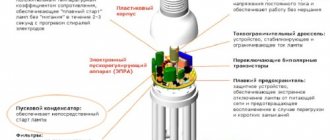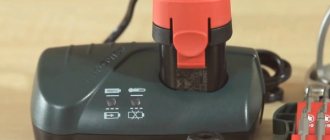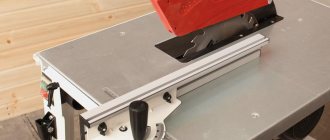Typical power supply diagram for a screwdriver
The power supply consists of a power transformer, a capacitor and a rectifier. The presented circuit for powering a screwdriver from a network with a rated voltage of 220V is designed for 12-volt devices.
Circuit example
Transformers in a typical circuit are selected with a power of 300 W or more. The second winding has a voltage varying around 20-24V. The current strength should not be less than 15A. Diode bridges also depend on the voltage of winding II. The capacitor located at the output must have a capacity of at least 470 μF, and the input voltage must be at least 25V. The elements are installed in a board tightly fixed in a housing of the required size. After this, the screwdriver is connected to a 220V electrical network and checked with a multimeter to ensure that all parameters are met.
How to make screwdriver power supplies from energy-saving light bulbs?
Modern power tools are popular because they allow you not to be tied to an electrical outlet during operation, which expands the possibilities of their use, even in field conditions. The presence of a rechargeable battery significantly limits the duration of active work, so screwdrivers and drills require constant access to a power source. Unfortunately, in modern tools (usually made in China), the power supply battery has little reliability and often quickly fails, so craftsmen have to make do with improvised materials in order not only to assemble a switching power supply, but also to save money on it. An example of such a hand-made product is a switching power supply (UPS) for an 18 V cordless screwdriver, assembled from the elements of a non-working energy-saving lamp, which can be useful even after its “death”.
The structure and principle of operation of an energy-saving lamp
The structure of an energy-saving lamp
To understand how an energy-saving lamp can be useful, let’s consider its structure. The design of the lamp consists of the following components:
- A sealed glass tube (flask), inside coated with a phosphor composition. The flask is filled with an inert gas (argon) and mercury vapor.
- Plastic housing made of non-flammable material.
- A small electronic board (electronic ballast) with a ballast, which is responsible for starting and eliminating flickering of the device. The control gear of modern devices is equipped with a filter that protects the lamp from network interference.
- A fuse that protects board components from power surges that could cause the device to catch fire.
- Housings - the ballasts, fuse and connecting wires are “packed” in it. Markings are placed on the case that contain information about voltage, power and color temperature.
- A base that ensures contact of the lamp with the power supply (the most common bases are E14, E27, GU10, G5.3).
Two spirals (electrodes) are connected to the lamp bulb, which, under the influence of current, become heated and emit electrons from their surface. As a result of the interaction of electrons with mercury vapor, a smoldering charge appears in the flask, which “gives birth” to UV radiation. By influencing the phosphor, ultraviolet light “makes” the lamp glow. The color temperature of the housekeeper is determined by the chemical composition of the phosphor.
Types of breakdowns of energy-saving lamps
An energy-saving lamp can fail in two cases:
- the lamp bulb broke;
- the electronic ballast (EB) (high-frequency voltage converter), which is responsible for converting alternating current into direct current, gradually heating the electrodes and preventing the device from flickering when turned on, has failed.
If the bulb is destroyed, the lamp can simply be thrown away, and if the electronic ballast breaks, it can be repaired or used for its own purposes, for example, used to make a UPS by adding an isolation transformer and a rectifier to the circuit.
Complete set of electronic ballast for energy-saving lamps Most EB lamps are high-frequency voltage converters assembled on semiconductor triodes (transistors). More expensive devices are equipped with a complex electronic circuit, while cheaper ones are equipped with a simplified one. The electronic ballast is “equipped” with the following electrical elements:
- bipolar transistor operating at voltages up to 700 V and currents up to 4A;
- protective diodes (mainly elements of the D4126L type or similar);
- pulse transformer;
- throttle;
- bidirectional dinistor, similar to dual KN102;
- capacitor 10/50V
- Some electronic circuits are equipped with field-effect transistors.
The figure below shows the composition of the lamp's electronic ballast with a functional description of each element.
Some EB circuits of energy-saving lamps allow you to almost completely replace the circuit of a homemade pulsed source, adding several elements to it and making minor changes.
Some converter circuits operate on electrolytic capacitors or contain a specialized microcircuit. It is better not to use such electronic circuits, because they are often the source of failures of many electronic devices.
What do the electrical circuits of housekeepers and UPS have in common?
Below is one of the common electrical circuits of the lamp, supplemented by an A-A' jumper that replaces the missing parts and lamp, a pulse transformer and a rectifier. Schematic elements highlighted in red can be deleted.
Electrical diagram of a 25 W “housekeeper”
As a result of some changes and necessary additions, as can be seen from the diagram below, it is possible to assemble a switching power supply, where the added elements are highlighted in red.
Final electrical diagram of the UPS
What power supply parameters can be achieved from an energy-saving lamp?
The “second” life of the “housekeeper” is often used by modern radio amateurs. After all, their hand-made products often require a power transformer, the availability of which poses certain difficulties, starting with its purchase and ending with the consumption of a large amount of wire for winding and the overall dimensions of the final product. Therefore, craftsmen have gotten used to replacing the transformer with a switching power supply. Moreover, if you use the electronic ballast of a faulty lighting device for these purposes, this will significantly save money, especially for a transformer with a power of more than 100 W.
A low-power switching power supply can be built by secondary winding the frame of an existing inductor. To obtain a higher power power supply, an additional transformer will be required. A 100 W switching power supply can be made on the basis of 20-30 W EB lamps, the circuit of which will have to be slightly modified by adding a rectifying diode bridge VD1-VD4 and increasing the cross-section of the inductor winding L0.
Homemade transformer power supply
If it is not possible to increase the gain of the transistors, you will have to increase their base current by changing the values of resistors R5-R6 to smaller ones. In addition, you will have to increase the power parameters of the base and emitter circuit resistors. At a low generation frequency, you will have to replace capacitors C4, C6 with elements with a higher capacity.
Homemade power supply
A low-power switching power supply with power parameters of 3.7-20 W does not require the use of a pulse transformer. To do this, it will be enough to increase the number of turns of the magnetic circuit on the existing inductor. The new winding can be wound over the old one. To do this, it is recommended to use MGTF wire with fluoroplastic insulation, which will fill the lumen of the magnetic circuit, which will not require a large amount of material and will provide the necessary power of the device.
To increase the power of the UPS, you will have to use a transformer, which can also be built on the basis of an existing EB choke. Only for this purpose it is recommended to use varnished winding copper wire, having previously wound a protective film on the original inductor winding to avoid breakdown. The optimal number of turns of the secondary winding is usually selected experimentally.
How to connect a new UPS to a screwdriver?
To connect a switching power supply assembled on the basis of an electronic ballast, you need to disassemble the screwdriver by removing all fasteners. Using soldering or heat-shrinkable tubing, we connect the device’s motor wires to the UPS output. Connecting wires by twisting is not a desirable contact, so we forget about it as unreliable. First, we drill a hole in the tool body through which we will run the wires. To prevent accidental tearing out, the wire must be crimped with an aluminum clip at the very hole in the inner surface of the power tool body. The size of the clip, which exceeds the diameter of the hole, will prevent the wire from being mechanically damaged and falling out of the housing.
As you can see, even after working out, an energy-saving lamp can last a long time, bringing benefits. On its basis, you can assemble a low-power pulse power supply unit up to 20 W, which will perfectly replace an 18 V power tool battery or any other charger. To do this, you can use the elements of the electronic ballast of an energy-saving lamp and the technology described above, which is what craftsmen use, most often to repair a faulty battery or save on the purchase of a new power source.
A screwdriver or cordless drill is a very convenient tool, but there is also a significant drawback - with active use, the battery discharges very quickly - in a few tens of minutes, and it takes hours to charge. Even having a spare battery doesn't help. A good way out when working indoors with a working 220V power supply would be an external source for powering the screwdriver from the mains, which could be used instead of a battery. But, unfortunately, specialized sources for powering screwdrivers from the mains are not commercially produced (only chargers for batteries, which cannot be used as a mains source due to insufficient output current, but only as a charger).
In the literature and on the Internet there are proposals to use car chargers based on a power transformer, as well as power supplies from personal computers and for halogen lighting lamps, as a power source for a screwdriver with a rated voltage of 13V. All of these are probably good options, but without pretending to be original, I suggest making a special power supply yourself. Moreover, based on the circuit I have given, you can make a power supply for another purpose.
And so, the source diagram is shown in the figure in the text of the article.
This is a classic flyback AC-DC converter based on the UC3842 PWM generator.
The voltage from the network is supplied to the bridge using diodes VD1-VD4. A constant voltage of about 300V is released at capacitor C1. This voltage powers a pulse generator with transformer T1 at the output. Initially, the triggering voltage is supplied to power pin 7 of IC A1 through resistor R1. The pulse generator of the microcircuit is turned on and produces pulses at pin 6. They are fed to the gate of the powerful field-effect transistor VT1 in the drain circuit of which the primary winding of the pulse transformer T1 is connected. The transformer begins to operate and secondary voltages appear on the secondary windings. The voltage from winding 7-11 is rectified by diode VD6 and is used to power microcircuit A1, which, having switched to constant generation mode, begins to consume current that the starting power supply on resistor R1 is not capable of supporting. Therefore, if the diode VD6 malfunctions, the source pulsates - through R1, capacitor C4 is charged to the voltage required to start the microcircuit generator, and when the generator starts, the increased current C4 discharges, and generation stops. Then the process is repeated. If VD6 is working properly, the circuit immediately after startup switches to power from winding 11-7 of transformer T1.
Secondary voltage 14V (at idle 15V, under full load 11V) is taken from winding 14-18. It is rectified by diode VD7 and smoothed by capacitor C7. Unlike the standard circuit, a protection circuit for the output switching transistor VT1 from increased drain-source current is not used here. And the protection input, pin 3 of the microcircuit, is simply connected to the common negative of the power supply. The reason for this decision is that the author does not have the necessary low-resistance resistor (after all, you have to make one from what is available). So the transistor here is not protected from overcurrent, which of course is not very good. However, the scheme has been working for a long time without this protection. However, if desired, you can easily make protection by following the typical connection diagram of the UC3842 IC.
Details.
Pulse transformer T1 is a ready-made TPI-8-1 from the power supply module MP-403 of a domestic color TV of type 3-USTST or 4-USTST. These TVs are now often dismantled or thrown away altogether. Yes, and TPI-8-1 transformers are available for sale. In the diagram, the terminal numbers of the transformer windings are shown according to the markings on it and on the circuit diagram of the MP-403 power module.
The TPI-8-1 transformer has other secondary windings, so you can get another 14V using winding 16-20 (or 28V by connecting 16-20 and 14-18 in series), 18V from winding 12-8, 29V from winding 12- 10 and 125V from winding 12-6. In this way, you can obtain a power source to power any electronic device, for example, an ULF with a preliminary stage.
However, the matter is limited to this, because rewinding the TPI-8-1 transformer is a rather thankless job. Its core is tightly glued and when you try to separate it, it breaks not where you expect. So, in general, you won’t be able to get any voltage from this unit, except perhaps with the help of a secondary step-down stabilizer.
Transistor IRF840
can be replaced with
IRFBC40
(which is basically the same), or with
BUZ90
,
KP707V2
.
KD202
diode can be replaced with any more modern rectifier diode with a direct current of at least
10A
.
As a radiator for transistor VT1,
you can use
the key transistor radiator MP-403
How to make a power supply for a 12V screwdriver
Creating a 12V power supply is not difficult because fewer parts are used inside the circuit. There is no need to solder resistors and transformers.
Replacing the battery with an assembled power supply
A suitable method is to place the voltage rectifier from another device into the battery case or connect them. Thus, the screwdriver becomes networked.
To perform the modification, you must follow the following instructions:
- Unscrew the 4 screws on the battery cover.
- Remove all radio components from the housing.
- Remove the printed circuit board from the power supply of the other device. It must be suitable in terms of power and voltage.
- Place the board into the battery case.
- Solder the wires.
- Drill a hole that will be used for input wires in the housing.
The lid is screwed into place. The power supply can be powered from a 220V network; the charging voltage will depend on the model of the voltage rectifier.
Conversion from a transformer with a rectifier
A toroidal core transformer is most effective for a screwdriver power supply. Such a transformer maintains its power density while maintaining a small size and simple design.
Toroidal transformer
The difficulty of the alteration lies in the coils; it is important to select the voltage by the number of turns. One turn equals 2 Volts, provided that the diameter of the transformer wire is 4 mm.
Different layers of turns must be insulated from each other. To make a rectifier for a cordless screwdriver with your own hands from a transformer, you need to have basic knowledge in the field of radio engineering and instrument making.
A transformer from an unnecessary or broken device, for example, an old tube TV, is suitable. The second winding should have a voltage in the region of 24-30 Volts; it is necessary to exceed the input voltage of the battery by 4-5 Volts. If the input voltage parameters meet the standards for creating a power supply for a 12V cordless screwdriver with your own hands, then you can start soldering the rectifier bridge.
The quality and origin of the transformer itself is important. 90% of success depends on it; the first transformer ring that comes across or is broken will not work.
An example of a low-quality transformer
It is correct to take transformers from power supplies for computers and televisions. The transformer ferrite ring should have a power in the region of 200-250 W. More powerful battery rings have dimensions that may interfere with the installation of the assembled power supply into the case. The electrical circuit should be protected from short circuits during assembly using fuses and transformer windings.
Power supply design
Homemade power supplies for screwdrivers can have various circuit and design options:
- Built into the housing of standard batteries;
- In the form of a separate block;
- Pulse;
- Transformer.
Now more about each of them.
Built-in
The undoubted advantage of built-in devices is that the only external parts that remain are a small cross-section power cord. Not everyone can make such a power supply on their own. This requires considerable experience, since small-sized powerful power supplies can only be made using a pulse circuit. A transformer of the required power of a classical design will not fit into the handle of a screwdriver, but with suitable dimensions it will have a power of several watts, which is only enough for idle operation.
Separate block
Due to the fact that the power supply is located outside the screwdriver body, there are no restrictions on dimensions and weight, so it can be made with the desired power reserve. The only limitation is the length and cross-sectional area of the connecting cords between the tool and the power source, because, according to Ohm’s law, when the voltage decreases with the same power consumption, the current increases, so the low-voltage power cord must have a larger cross-section than the 220 V mains cord. also a requirement to minimize the voltage drop on the wires. A thick cord has increased mass and rigidity, which reduces the ease of use of the tool.
Pulse sources
Switching power supplies are characterized by the fact that the step-down transformer in them operates at a higher frequency, as a result of which it has minimal dimensions at the same power. The overall dimensions of the device make it possible to place the structure in a standard case instead of faulty batteries. One of the disadvantages is the complexity of the design for independent repetition.
Transformer devices
Power supplies based on transformers have not yet lost their relevance due to their ease of manufacture and reliability. The only disadvantage of such products is their large dimensions and weight, but this is not significant when the device is made in the form of a separate unit and installed permanently.
Devices based on transformers have become predominantly widespread among home-made devices, so they will be considered in the most detail.
Transformer power supply design
This device is characterized by the presence of the following components:
- Power transformer;
- Rectifier:
- Power filter;
- Voltage regulator.
The power transformer is the largest and heaviest part of the device. It is designed to convert high input voltage to low voltage to meet the requirements of the connected load.
The rectifier's job is to convert alternating voltage to direct voltage. The most effective are bridge rectification circuits consisting of four diodes or a monolithic rectifier bridge.
The filter smoothes out voltage ripples after the rectifier bridge.
Theoretically, these elements are sufficient for the screwdriver to operate, but voltage surges in the supply network, voltage drops due to increased load can lead to unstable operation of the engine, and an increase above normal can lead to failure.
The task of the stabilizer is to maintain a stable output voltage, regardless of the load size and the voltage level of the supply network.
For self-assembly, we can recommend a simple, proven stabilizer circuit, which has a minimum of parts and can be repeated by anyone who knows how to hold a soldering iron and use measuring instruments.
In the above circuit, you can increase the capacitance of the capacitor to 1000-2000 μF, and use transistors of types KT807, KT819 with any letter.
The main problem is selecting a transformer with the required output voltage level. It should be slightly larger than what is required for the tool, since part will remain on the stabilizer elements. For normal operation of the stabilizer, it is required that the rectified voltage exceeds the stabilized voltage by several volts. Too much is not allowed, since its excess will fall on the key transistor, heating it, and a low value in some cases will lead to a decrease in the output voltage.
Note! After the bridge rectifier and filter, the DC voltage value will exceed the AC input by approximately 1.4 times.
Thus, a power supply for a 12V screwdriver requires a transformer with an output voltage of 12-14V AC.
Important! The transistor must be mounted on the cooling radiator.
Using the computer's power supply
It is rational to assemble a power supply for a screwdriver with a 12V motor with your own hands from a power supply from a computer. The standard voltages of the motherboard and external devices of the computer are:
Standard power supplies are capable of delivering a current of up to 10-15 A in a +12 V circuit, which is absolutely acceptable for most models of screwdrivers. At the power connectors, the required voltage is present on the black (ground) and yellow wires. The remaining wires are not needed, and it is advisable to solder them directly on the power supply board so that they do not interfere and do not create a reason for a short circuit.
In some cases, it may be possible to use a computer power supply for a 14 V screwdriver. However, there will be a slight drop in power. But 16 and 18 Volt screwdrivers will not work with such devices. If you have qualifications, you can make changes to the circuit of a standard power supply in order to increase the voltage, but this is usually not possible for the average user.
Note! All of the above applies to outdated, but still available AT power supplies. More modern ATX requires some modifications to enable it, since it is organized on the computer motherboard with a special circuit.
With due care, you can do this yourself. To do this, you need to find a green wire on the largest connector of the device. By connecting it through the button to the black ground wire, you can turn on the power supply.
Using either source does not require any changes to the instrument design. To supply voltage, you should use the housing from faulty batteries, drilling holes in it for the power wires. The conductors themselves must be carefully soldered to the output terminals, without melting the plastic, strictly observing polarity.
The assembled structure must be placed in a suitable housing and, if necessary, provided with a carrying handle.
Transformerless devices
On the Internet you can find recommendations for modifying ballasts of powerful fluorescent lamps (housekeepers) for use as a power supply for a screwdriver. But few places say that such structures have a galvanic connection to the AC network and are unsafe to use. Do not repeat similar designs and run the risk of electric shock.
Designing an external source can serve as a temporary measure as a replacement for batteries, since mobility and independence from the network are the main advantages of battery devices. It’s inconvenient when the power cord gets tangled and interferes with your work, especially in hard-to-reach places.
Source: amperof.ru
DIY 14V power supply from Chinese appliances
An inexpensive way to create a power supply for a 14V screwdriver is to remake it from Chinese power supplies. Their input voltage is slightly higher: the resistors should be replaced.
To do this you should:
- Remove resistor R10 from the electrical circuit of the Chinese power supply. The resistance of the fixed resistor is 2320 Ohms.
- Solder the old power supply resistor into the printed circuit board.
- Set the resistance to 2300 Ohms.
The current strength should not exceed 9A, otherwise the power supply for the screwdriver will soon stop working.
Next, the resulting circuit is mounted in the screwdriver body; the radio elements are first isolated to prevent short circuits. Make ventilation holes in the housing of the screwdriver power supply. Next, the tool is connected to a 220 Volt network and the functionality is checked.
In the same way, you can make a power supply from any purchased resistors. The easiest way to convert the circuit is to solder in additional diodes. The Chinese resistor is soldered off and replaced with an analogue one with the possibility of indirectly reducing the input voltage.
Conversion from a computer power supply
The AT power supply standard is suitable for conversion. The average output voltage is 14 V, and the average power does not exceed 400 W. These values are ideal for a 14V screwdriver power supply. You can take it from an old computer. The computer power supply comes with a built-in fuse and cooler. The main disadvantage is the dimensions of the PC component.
computer power supply
Power supplies for ATX standard computer system units are not suitable. They are more complex and creating a power supply for a screwdriver from them requires thorough knowledge of electronics. PSUs of the ATX standard require significant intervention in the design so that they can be built into a screwdriver. To remake an AT standard power supply, you should:
- Disassemble the computer system unit.
- Disconnect the power supplied by the green wire.
- Unsolder the black and green wires.
- Connect the black wire to black and the green wire to yellow.
- Solder one end of the green wires to the soldered black socket.
- Connect the second end of the green wire to the contacts of the screwdriver power supply.
If there is a red wire in the computer power supply, then it should be unsoldered. It is needed to control the load on the +5 V bus. Next, the incoming voltage is checked. If there is a value of 14 Volts, then the modified power supply is assembled. After this, the block is connected to the black and yellow wires. A screwdriver will be connected to it. When soldering, it is important to observe polarities. The black wire is on “-”, and the yellow wire is on “+”.
It is important to ensure that the power cord and wires do not get twisted during the remodeling process.
How to make an 18V power supply instead of a battery
Power supplies for an 18V screwdriver are not easy to make with your own hands from improvised means and old electrical appliances. For example, the option for converting a 12V car battery into a computer power supply is not suitable. Professionals in radio engineering suggest assembling the unit yourself.
18 Volt power supply
Take into account the dimensions of the charger so that it can be mounted in the battery compartment of the screwdriver. Also, before remodeling, it is necessary to compare the input power parameters of the charger and power supply. If there is insufficient voltage, the screwdriver will not work with the required efficiency, and if there is too much voltage, overvoltage will occur and the elements of the electrical circuit will fail.
To place the power supply for an 18V cordless screwdriver instead of a battery in the case:
- Unscrew the battery cover.
- Clean the housing from all parts.
- Remove the printed circuit board from the screwdriver power supply.
- Install the board into the case in which the battery was located.
- Solder the output wires according to the contacts.
- Drill a hole for the input wires in the housing.
Assembled power supply
A dismountable mains transformer will do. The power of the part should not exceed 250 W, otherwise the design will not work. It is necessary to disassemble the transformer and wind up the secondary windings except the mains winding. Then the wire is wound onto 1 secondary winding and the required number of turns is obtained, producing the appropriate voltage and current.
Power transformer
You will also need a non-polarized paper capacitor. Approximate capacitance = 1 µF, and voltage not exceeding 400 Volts (optional). Any rectifier models that pass 10-20 Amperes of current are suitable as diodes. The minimum voltage on the return path must be at least 30 Volts.
DIY power supply for 18 V screwdriver
The weakest point in household screwdrivers is the battery. Like any galvanic element, it has its own service life. The battery for a screwdriver lasts on average 3–4 years, no more, and then must be disposed of. By the way, claims that with proper care and maintenance it will last 10 years are clearly exaggerated.
How to give a screwdriver a second life if the battery has failed?
Switching power supply for 18 V screwdriver: diagram
There is a way out, and there is more than one. You can purchase a new battery. But the price of such a device may exceed the cost of the entire instrument purchased several years ago. Therefore, the most acceptable solution would be to convert the screwdriver to mains voltage.
Options for connecting a screwdriver to a 220 V network
One solution would be to create a power supply yourself. There are many options for creating a homemade power supply:
- universal option;
- with a two-pole resistor;
- with three-pole resistor;
- with amplifier;
- with and without zener diode;
- on one filter.
However, they have proven themselves to be the most reliable pulse modifications.
Component elements of the switching power supply circuit
Making a switching power supply for an 18 V hand tool with your own hands is not at all difficult. For this you will need:
- Output capacitor 5 pF.
- Resistor.
- Integrated negative directivity converter.
- Comparator with two or three plates.
- Low resistance rectifier.
- Channel filters with beam adapters.
- Schematic diagram of a switching power supply.
Connecting a cordless screwdriver to a 220 V network: AC adapter
The electric drive of the screwdriver can be driven from a 220 V network by a network adapter. It can be purchased ready-made - the price allows it. You can do it yourself. The purchased adapter must be inserted into the battery housing of the screwdriver, having first removed the batteries. The only drawback is the short length of the cord.
DIY power adapter for a screwdriver: materials
The process of converting a cordless screwdriver into a corded one is simple and does not take much time. To do this you need to have:
- Laptop charger.
- Screwdriver with used battery.
- Electrical wire.
- Electrical tape.
- Soldering iron and solder.
- Acid.
Do-it-yourself power adapter for a screwdriver: step-by-step instructions
The rework process includes the following steps:
- First you need to measure the output voltage on the device. It should be 19 V.
- After this you need to take the battery and disassemble it. If it is twisted with screws, then simply unscrew them; if it is glued, then you must first tap it with a rubber hammer. Clean the housing from dirt and prepare it for further work by drilling a hole in it for the power cable.
- Now you need to cut off the connector and strip the wires of insulation.
- The battery should not be thrown away immediately. It can serve as a counterweight for some time. The center of gravity of the screwdriver is shifted and is located in the area of the handle. When the galvanic elements are removed, its location will change, and it will be inconvenient to work with the tool.
- You need to connect an extended cable from the laptop charging to the wires coming from the battery terminals. It must first be passed through a prepared hole in the housing. The cable can be soldered or twisted and insulated with electrical tape.
- When everything is ready, you need to put everything in the case and check the polarity. After this, test the screwdriver.
Power supply for 18 V cordless screwdriver based on an electronic transformer
Another solution for converting a cordless screwdriver to a 220 V network is to use an electronic transformer.
Materials for assembling a transformer power supply
To do this you need the following details:
- Electronic transformer TOSHIBA 105 W or Kamelion 200–250 W. The latter device additionally has short circuit protection.
- Ultrafast diodes KD213 or KD 2999, KD 2997 for 10 A, 4 pcs.
- Choke from a computer power supply.
- Electrolytic capacitor 2200 mF at 25 V.
- 220 nF film capacitor at 25 V.
- Load resistor 1–2 kOhm.
Procedure for assembling a transformer power supply
- The process begins with the modification of the electronic transformer. 4 turns must be added to the secondary winding.
- After this, you can assemble the diode bridge. The circuit assembly is carried out by surface mounting or everything is placed on a printed circuit board.
- Then you need to install a choke in the circuit. A 2200 mF capacitor at 25 V is soldered behind it. This is the optimal capacitance of the device. Neither more nor less is needed.
- A film capacitor must be installed in parallel with the electrolyte. It is needed to ensure that high-frequency residues do not damage the main capacitor, but pass through the film capacitor.
- A load resistor must be installed at the output. It will provide the same voltage value, regardless of the load, and will prevent the failure of capacitors.
- After this, a capacitor must be installed in the electronic transformer to enable starting without load.
- The first time you need to turn on the power supply to the network using a 40 W test light. This is necessary to prevent a short circuit that may have occurred during rewinding of the transformer or assembly. If the lamp does not light up, then everything was done correctly.
- After this, you need to remove the control and check the block under load by connecting it to a screwdriver.
- The resulting unit can be placed in the tool's battery housing.
The reader, having familiarized himself with the information presented in this article, can give his screwdriver a second life. To do this, it is enough to choose the most acceptable method of converting a battery tool for a 220 V network.
Switching power supply for screwdriver
In pulse units, the input voltage is converted into high-frequency pulses after passing through a rectifier. There are enough diagrams for self-assembly of the device. To create it you need to have knowledge in the field of radio engineering and electronics.
The simplest pulse power supply
Scheme of a switching power supply for a cordless screwdriver - bridge-type rectifier. In the figure below, instead of diodes, there are analog field-effect transistors. The comparator is used to monitor the operation of the transistors and compare the voltage at the capacitor and the output of the transformer. As current flows through the transistor diodes, the rectifier begins to operate. This occurs at startup, when the rectifier capacitor receives a voltage of approximately 5 Volts.
18V pulse block circuit
A thermostat can be built into the circuit. It is needed for emergency shutdown of the device if overheating occurs. A built-in thermostat is optional, but it protects the ballast resistor.
When the capacitor receives a voltage of 10 Volts, the comparator in cell D1 will start working. The relay contacts are connected by shunts to bypass the ballast resistor. The voltage is supplied from the triac in cell T1, which is opened by the comparator when the capacitor is charged. The circuit has built-in LEDs that indicate the functionality of the charger.
Charger LEDs
This switching power supply is designed for 18 Volts, but the voltage is adjustable. To do this, you need to make a larger or smaller number of turns of the transformer.
Sequence of actions when assembling a switching power supply circuit:
- Place a thermistor at the input and mount a diode bridge.
- Solder the transistors.
- Solder the capacitors.
- Install diodes at the output.
Field-effect transistors are synchronized by installing drivers. Do not short-circuit the transistor flanges. Attached using washers for insulation.
DIY power supply for a screwdriver
The standard charger uses a three-channel chip. Depending on the voltage, a different number of transistors are placed on it, for example, 4 transistors are installed in a 12-volt charger. To reduce the negative effects of clock frequency, capacitors are installed in the blocks. They are of impulse or transient type. To minimize the consequences of electrical network overloads, thyristors are used in chargers.
Standard screwdriver charging circuit
This is important: in different models, not only different numbers of transistors are installed - they differ significantly in their capacity.
Power supply for a screwdriver from an energy-saving lamp In order to make a UPS from an energy-saving lamp, it is necessary to slightly change the electronic choke contained in each lamp by placing a jumper, and then connect it to a pulse transformer and rectifier. For low-power power supplies (from 3.7 V to 20 watts), you can do without a transformer. To do this, you simply need to add a few turns of semiconductor to the magnetic circuit of the inductor located in the lamp ballast, if there is room for this. The winding can be done directly over the factory one. To do this, it is better to use a wire with fluoroplastic insulation.
Power supply for screwdriver from charger
One of the cheapest ways to make a power bank is to use a regular smartphone charger. Every home now has two or more of them, and if you don’t have any extra, you can buy them for 50–100 rubles.
This is what the insides of a smartphone charger look like
The charging modification is carried out in the following sequence:
• Using a small diameter enamelled conductor, one turn of the winding must be added. After that, turn on the charger and connect the screwdriver to the battery. Using an oscilloscope, we measure the amplitude of the pulses and determine the voltage created by one turn of the additional winding. • Unsolder the USB connector, remove the test turn and wind the required number of turns until the required voltage is obtained. The new winding is soldered to the factory one in series. • We replace the standard capacitor and zener diode with new ones that correspond to the required voltage.
DIY switching power supply for a screwdriver
A suitable microcircuit is selected for the pulse unit, and assembly is carried out in the following sequence:
• Diode bridges and a thermistor are placed at the input. • Two capacitors are installed. • Drivers are used to synchronize the operation of the gates of field-effect transistors. • When installing transistors, the flanges are not short-circuited. They are attached to the radiator using insulating washers and gaskets. • Diodes are installed at the output.
Power supply for a screwdriver made from an electronic transformer
To adapt the transformer to the charger of your tool, it needs to be modified. To do this, you need to connect a capacitor at the output of the rectifier bridge. Capacitance is determined as follows - 1 µF per 1 W. The capacitor voltage must be at least 400 V. A thermistor must be installed in the gap of one network cable to limit the inrush current. A diode bridge is installed to rectify voltage with a frequency of 30 kHz. For normal operation of the device, a smooth start is required. Throttle L1 copes with this perfectly.
Rules for operating power supplies
The case into which the power supply is built must have ventilation holes to prevent overheating. Also, if there are no cooling systems, you need to install a fan.
PSU with ventilation holes
In order for a homemade power supply for a screwdriver to work for a long time, you should let it cool down every 30-40 minutes of operation. It is necessary to monitor the temperature of the case, the condition of the cable, and also periodically check the contacts in the electrical circuit if there are any suspicions. Poor soldering of elements and non-observance of polarities can lead to failure of the circuit or short circuit.
When remaking a homemade device, do not neglect the origin of the parts. They must match the input parameters of power, voltage, current flow and resistance. Diode bridges and transformers are the basis of the entire circuit; the performance of the screwdriver’s power supply depends on their selection.










